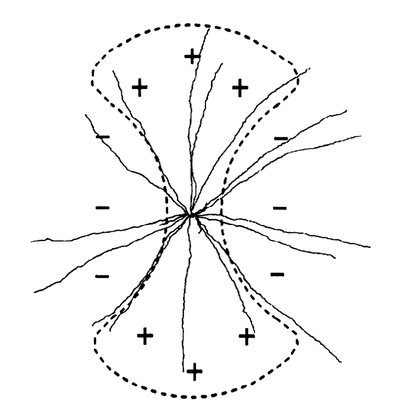Latest revision as of 17:03, 17 November 2015
Information about message (contribute ) This message has no documentation.
If you know where or how this message is used, you can help other translators by adding documentation to this message.
Message definition (Orientation Selective Ganglion Cell )
[[Image: arbors1.png|thumb|400px|The receptive field of an orientation selective ganglion cell, with an excitatory center (+) and inhibitory surround (-).<ref name="Bloomfield">Bloomfield SA(1994) Orientation-sensitive amacrine and ganglion cells in the rabbit retina. J Neurophysiol 71:1672-1691.
[[Image: arbors1.png|thumb|400px|The receptive field of an orientation selective ganglion cell, with an excitatory center (+) and inhibitory surround (-).<ref name="Bloomfield">Bloomfield SA(1994) Orientation-sensitive amacrine and ganglion cells in the rabbit retina. J Neurophysiol 71:1672-1691.
http://jn.physiology.org/content/71/5/1672.abstract?ijkey=4cfa4066fd39257147ad90ee1df8864247a4132f&keytype2=tf_ipsecsha</ref>]]
===AMPA and NMDA Receptors===
AMPA and NMDA receptors have been found to play a significant role in signal integration in ganglion cells found in rabbit retinas.<ref name="Marc2">Marc RE (1999) Mapping glutamatergic drive in the vertebrate retina with a channel-permeant organic cation. J Comp Neurol, 407(1):47-64. http://onlinelibrary.wiley.com/doi/10.1002/(SICI)1096-9861(19990428)407:1%3C47::AID-CNE4%3E3.0.CO;2-0/abstract</ref> AGB cation was used to evaluate the differences in permeability of the different ganglion cells types when kainate, AMPA, and NMDA receptors were activated. Translation [[Image: arbors1.png|thumb|400px|The receptive field of an orientation selective ganglion cell, with an excitatory center (+) and inhibitory surround (-).<ref name="Bloomfield">Bloomfield SA(1994) Orientation-sensitive amacrine and ganglion cells in the rabbit retina. J Neurophysiol 71:1672-1691. The receptive field of an orientation selective ganglion cell, with an excitatory center (+) and inhibitory surround (-).
[1] AMPA and NMDA Receptors
AMPA and NMDA receptors have been found to play a significant role in signal integration in ganglion cells found in rabbit retinas.
[2] AGB cation was used to evaluate the differences in permeability of the different ganglion cells types when kainate, AMPA, and NMDA receptors were activated.
↑ Bloomfield SA(1994) Orientation-sensitive amacrine and ganglion cells in the rabbit retina. J Neurophysiol 71:1672-1691.
http://jn.physiology.org/content/71/5/1672.abstract?ijkey=4cfa4066fd39257147ad90ee1df8864247a4132f&keytype2=tf_ipsecsha
↑ Marc RE (1999) Mapping glutamatergic drive in the vertebrate retina with a channel-permeant organic cation. J Comp Neurol, 407(1):47-64. http://onlinelibrary.wiley.com/doi/10.1002/(SICI)1096-9861(19990428)407:1%3C47::AID-CNE4%3E3.0.CO;2-0/abstract
